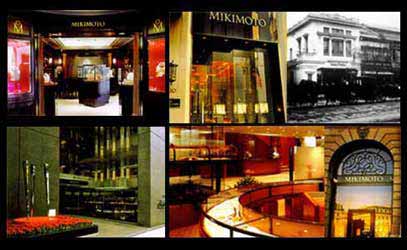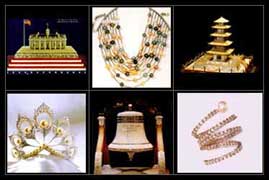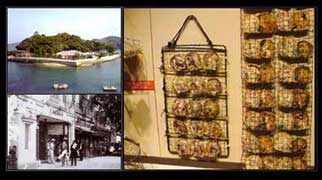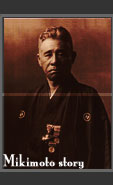In
the mid 1800's, Japan had shed centuries of isolation and become
deeply involved in foreign trade. Japan's marine treasures, the
beautiful natural pearls that were so valued by the Japanese were
also regarded as most precious in the international market which
coveted them intensely. Consequently as often happens with fragile
natural resources that take a long time to replenish, the pearls
were being over harvested and the situation had reached a crisis
point.
|
|
|
For
Kokichi who loved pearls, the fear of their depletion and the extinction
of the oysters that produced them was the right catalyst to spur
him to try and cultivate them and thus gave birth to the multi million
dollar cultured pearl industry. Kokichi threw himself and all his
resources into experimenting with the creation of cultured pearls.
Success did not come immediately, in fact as with all trial and
error processes, there were more failures than triumphs and more
discouraging moments than exhilarating ones but the ultimate prize
was worth all the tribulations and so he persevered.
|
The
first cultured semi-spherical pearl for which Kokichi Mikimoto got
patent no. 2670 |
|
For
decades, he spent every waking moment on seeding oysters, researching
and experimenting. Adding to his worries were the impediments imposed
by nature herself. Factors such as the mysterious red tides and
low water temperatures led to repeated failures. A lesser man would
certainly have given up in the face of all these natural complications
which are beyond the power of human intervention. Kokichi Mikimoto
was a stubborn man however and not one to give up regardless of
the factors against him. His determination paid off finally and
the day he had been waiting for came on July 11, 1893. Accompanied
by his wife Ume, he raised a bamboo oyster basket out of the water,
opened one of the oysters and there inside the shell nestled a shining
pearl. |
|
1-2
Kokichi Mikimoto pours low quality cultured pearls into a bonfire
in front of the Kobe Chamber of Commerce in 1932.
3-4 Mikimoto opened a pearl farm on the South Pacific island of
Palau in 1922.
5. Kokichi Mikimoto, founder of the Mikimoto, empire.
|
Once,
he had tasted success, he did not intend to stop. He built upon
the method that had been discovered independently by him and two
others, also in Japan. However, they had already taken out a patent
on the process, which they had named after themselves, the Mise-Nishikawa
method. So Kokichi had to go back to the drawing board. He realised
that their method produced what we know of as Mabe pearls, so now
he worked on a method to produce round pearls. He succeeded in that
in 1905. His success allowed him the means to buy the rights to
the earlier patent.
Once
he had become proficient at culturing perfectly spherical pearls,
Kokichi turned his attention to the beauty of the black-lipped pearl
and the silver-lipped pearl. In 1914, he opened a culturing site
for black lipped pearl oysters on Ishigaki island in Okinawa. As
usual the forces of nature, especially the frequent typhoons, proved
to be daunting obstacles but nevertheless Kokichi proved successful
in culturing a 10mm pearl in 1931. He dispatched a team of researchers
to the South Pacific island of Palau, where they had considerable
success in culturing pearls. While trying to meet the challenge
of producing black-lipped and silver-lipped pearls, he simultaneously
encouraged the development of local pearl industries on these hitherto
underdeveloped islands where even today the name Mikimoto is uttered
with reverence.
|
Shortly
after he had succeeded in culturing a perfectly round pearl,
Kokichi Mikimoto declared "I would like to adorn the
necks of all the women in the world with pearls." He
had already taken the first step down this path with the
opening of the first Mikimoto pearl store in Tokyo's Ginza
area in 1899. It was the world's first store specialising
entirely in pearl jewellery. The concept worked and in 1906
he moved the store to a new building in Ginza 4-chome. The
Mikimoto Pearl Store housed in a two storey western type
building made of white stone was very modern and westernised
for its time. Inside young men dressed in high collared
three piece suits waited on the customers. The jewellery
was made after the contemporary fashion and each month the
store featured new displays conceived by expert designers. |
|
|
|
1. Princess Grace Collection
launched in 2002
2. 1969 -Mikimoto wins De Beers Diamonds International Awards for
the fist time with this brooch "Prelude to Space"
|
Kokichi
spared no effort to keep abreast of the latest knowledge of fashion
and design from around the world so that Mikimoto jewellery always
stayed on the contemporary edge. He sent his best employees abroad
to learn about the latest designs and Grafting technology and incorporate
these ideas into the working of his own company. He was certain
that if he mastered selection of materials and design, engraving
technology and other specialities of jewellery making, he would
be able to create jewels that the whole world could appreciate and
cherish. Thus he set up the Mikimoto Gold Work Factory in Tokyo's
Tsukiji area in 1907. He hired a specialised team of craftsmen and
invited jewellery designers to come and work exclusively for the
Ginza store.
|
1
In every fine jewellery centre,
there is a Mikimoto showroom
that offers customers
the finest pearls guaranteed
by the Mikimoto name. |
|
 |
|
The
result of all this work was that the Mikimoto Pearl Store
became well established and its fame spread beyond the borders
of Japan to span the whole world. This led to the opening
of a Mikimoto store in London in 1913, followed in quick
succession by stores in Paris, New York, Chicago, Los Angeles,
San Francisco, Shanghai and Bombay. |
|
 |
|
1
Model of George Washington's residence exhibited at the
Chicago World's Fair in 1933.
2 Five storied pearl pagoda displayed
at the Philadelphia World's Fair 1926.
3 The Miss Universe Crown donated by Mikimoto.
4 Mikimoto Liberty Bell displayed at the
New New York World's Fair in 1939.
|
|
Apart
from pearls, there was one other thing that Kokichi had mastered
and that was public relations and publicity. He therefore grabbed
every opportunity to display his creations. Beginning with the World
Exposition in Philadelphia in 1926, he went on to exhibit at expositions
in cities such as Chicago, New York and Paris. While he was there,
he did not only display jewellery but also made sure that his booth
held a major conversation piece that would prove to be a magnet
and attract all the visitors to come and take a look. Therefore,
in the 1926 Philadelphia exposition he displayed a five storied
pearl pagoda. In 1933, it was a model of George Washington's residence
at the Chicago World's Fair. At the New York World's Fair in 1939,
he displayed the Mikimoto Liberty Bell.
|
 |
|
1 Mikimoto
Pearl Island.
2 Oyster Cages. |
| |
|
|
|
In
fact, due to the efforts of Kokichi Mikimoto and his company, in
the 1930's the popularity of pearls had gone up worldwide and with
it there was an accompanying expansion of the cultured pearl industry
and thus a new industry took root in Japan. However, most of the
pearl farms were unable to maintain quality standards and crude,
inferior pearls began to appear on the market. In a brilliant piece
of well staged publicity, Kokichi went to the plaza in front of
the Kobe Chamber of Commerce (the office that had most to do with
foreign trade at the time) and threw a succession of low quality
pearls in to a blazing bonfire. It was his way of drawing society's
attention to the importance of quality. Responding to insistent
demands from both Japan and abroad to maintain the quality of cultured
pearls, Kokichi founded the Japan Pearl Producers Association. |
|
Kokichi
Mikimoto passed away in 1954 at the age of 96 but the legend that
he built endures. Today the name Mikimoto is emblematic of the cultured
pearl both in Japan and throughout the world. The foundation that
was built on quality ensures that customers around the globe can
confidently buy their pearls from Mikimoto as the name itself is
the guarantee that these pearls are the best to be found. |
|





















